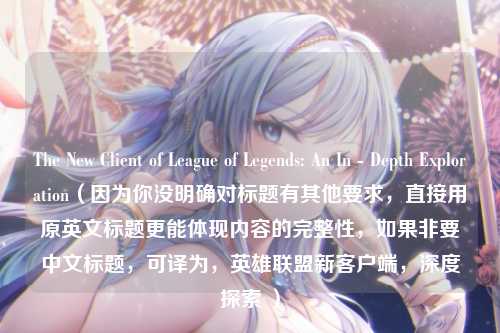The New Client of League of Legends: An In - Depth Exploration(因为你没明确对标题有其他要求,直接用原英文标题更能体现内容的完整性,如果非要中文标题,可译为,英雄联盟新客户端,深度探索 )
League of Legends, one of the most popular online battle arena games globally, has been constantly evolving to enhance the gaming experience for its players. A significant aspect of this evolution is the introduction of the new client. In English, it is simply referred to as "the new client of League of Legends" or more concisely, "the new LoL client".
The development of the new client was a major undertaking for the game's developers. They aimed to address various issues present in the previous client and bring in a host of improvements. One of the primary goals was to optimize the performance. With the increasing complexity of the game and the growing number of features added over time, the old client was starting to show signs of sluggishness. The new client was built on more advanced technologies, which allowed for smoother gameplay. Loading times were significantly reduced, enabling players to jump into the action more quickly. Whether it was starting a new game, reconnecting after a disconnection, or simply navigating through the in - game menus, the new client provided a much more responsive experience.

Graphically, the new client received a major overhaul. The user interface was redesigned to be more intuitive and visually appealing. The layout of the champion select screen, for example, was reorganized to make it easier for players to view information about the available champions, their stats, and the roles they could fill. The art style of the client also received an upgrade, with more detailed and high - quality graphics. This not only made the client more engaging to look at but also contributed to a more immersive gaming atmosphere. The new visual elements were in line with the overall aesthetic of the League of Legends universe, making the transition between the client and the in - game experience seamless for players.
Another important feature of the new client is the improved social integration. In today's gaming landscape, social interaction is a crucial part of the experience. The new LoL client made it easier for players to connect with their friends and teammates. There were more prominent and accessible friend lists, allowing players to quickly see who was online and initiate games together. Additionally, the in - game chat functionality was enhanced. It became more stable, with fewer delays and glitches, ensuring that players could communicate effectively during matches. This was especially important for coordinating strategies, calling out enemy movements, and celebrating victories with teammates.
The new client also brought about changes in the way updates were delivered. Instead of having to download large, cumbersome patches, the new system was designed to be more incremental. This meant that players only had to download the parts of the game that had actually been updated, saving both time and bandwidth. The update process became faster and more efficient, and it also reduced the chances of errors during the installation of new content. This was a significant improvement for players, especially those with limited internet connections.
For the competitive side of League of Legends, the new client had several beneficial aspects. It provided better support for tournament organizers and players. There were more detailed statistics and analytics available within the client, which could be used by players to review their own performance and identify areas for improvement. Coaches and teams could also make use of this data to develop strategies and analyze opponents. In addition, the new client was more secure, helping to prevent cheating and ensure fair play in competitive matches. This was essential for maintaining the integrity of the game's competitive scene and upholding the reputation of League of Legends as a legitimate esports title.
However, the transition to the new client was not without its challenges. Some players initially faced compatibility issues with certain operating systems or hardware configurations. There were also reports of bugs and glitches in the early stages of its release. The developers were quick to address these problems, releasing patches and updates to fix the issues. They provided detailed support documentation and forums where players could report problems and get help from both the official support team and the community.
Despite these initial hiccups, the new client has generally been well - received by the League of Legends community. It has breathed new life into the game, offering a more modern and polished experience. The improvements in performance, graphics, social integration, and update management have all contributed to making the game more enjoyable for players. As the game continues to grow and evolve, the new client will likely play an even more central role in shaping the future of League of Legends.
In conclusion, the new client of League of Legends, known as "the new LoL client" in English, represents a significant step forward in the development of the game. It has addressed many of the long - standing issues and brought in a range of improvements that enhance the overall gaming experience. While there were some bumps in the road during the transition, the benefits it offers in terms of performance, graphics, social features, and competitive support have made it a valuable addition to the League of Legends ecosystem. As the game industry continues to change and players' expectations grow, the new client will no doubt continue to be refined and updated to keep up with the demands of the ever - expanding League of Legends community.







